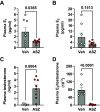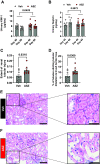Aromatase inhibition increases blood pressure and markers of renal injury in female rats
- PMID: 35900340
- PMCID: PMC9423724
- DOI: 10.1152/ajprenal.00055.2022
Aromatase inhibition increases blood pressure and markers of renal injury in female rats
Abstract
Aromatase is a monooxygenase that catalyzes the rate-limiting step of estrogen biosynthesis from androgens. Aromatase inhibitors are widely used for the treatment of patients with hormone receptor-positive breast cancer. However, the effects of aromatase inhibitors on cardiovascular and renal health in females are understudied. Given that estrogen is protective against cardiovascular and kidney diseases, we hypothesized that aromatase inhibition elevates blood pressure and induces kidney injury in female Sprague-Dawley rats. Twelve-week-old female rats were implanted with radiotelemetry transmitters to continuously monitor blood pressure. After baseline blood pressure recording, rats were randomly assigned to treatment with the aromatase inhibitor anastrozole (ASZ) or vehicle (Veh) in drinking water. Twenty days after treatment initiation, rats were shifted from a normal-salt (NS) diet to a high-salt (HS) diet for an additional 40 days. Rats were euthanized 60 days after treatment initiation. Body weight increased in both groups over the study period, but the increase was greater in the ASZ-treated group than in the Veh-treated group. Mean arterial pressure increased in ASZ-treated rats during the NS and HS diet phases but remained unchanged in Veh-treated rats. In addition, urinary excretion of albumin and kidney injury marker-1 and plasma urea were increased in response to aromatase inhibition. Furthermore, histological assessment revealed that ASZ treatment increased morphological evidence of renal tubular injury and proximal tubular brush border loss. In conclusion, chronic aromatase inhibition in vivo with ASZ increases blood pressure and markers of renal proximal tubular injury in female Sprague-Dawley rats, suggesting an important role for aromatization in the maintenance cardiovascular and renal health in females.NEW & NOTEWORTHY Aromatase enzyme catalyzes the rate-limiting step in estrogen biosynthesis. Aromatase inhibitors are clinically used for the treatment of patients with breast cancer; however, the impact of inhibiting aromatization on blood pressure and renal function is incompletely understood. The present findings demonstrate that systemic anastrozole treatment increases blood pressure and renal tubular injury markers in female rats fed a high-salt diet, suggesting an important role for aromatization in preserving cardiovascular and renal health in females.
Keywords: anastrozole; dietary sodium; estrogen; hypertension; proximal tubule.
Conflict of interest statement
E.Y.G. is also affiliated with the Department of Pharmacology and Toxicology, Faculty of Pharmacy, Alexandria University, Egypt. None of the other authors has any conflicts of interest, financial or otherwise, to disclose.
Figures







Similar articles
-
Aromatase enzyme: Paving the way for exploring aromatization for cardio-renal protection.Biomed Pharmacother. 2023 Dec;168:115832. doi: 10.1016/j.biopha.2023.115832. Epub 2023 Nov 6. Biomed Pharmacother. 2023. PMID: 37931519 Free PMC article. Review.
-
Activation of G protein-coupled estrogen receptor 1 ameliorates proximal tubular injury and proteinuria in Dahl salt-sensitive female rats.Am J Physiol Regul Integr Comp Physiol. 2021 Mar 1;320(3):R297-R306. doi: 10.1152/ajpregu.00267.2020. Epub 2021 Jan 6. Am J Physiol Regul Integr Comp Physiol. 2021. PMID: 33407017 Free PMC article.
-
Increased salt sensitivity induced by impairment of sensory nerves: is nephropathy the cause?J Hypertens. 2003 Feb;21(2):403-9. doi: 10.1097/00004872-200302000-00033. J Hypertens. 2003. PMID: 12569272
-
Influence of letrozole and anastrozole on total body aromatization and plasma estrogen levels in postmenopausal breast cancer patients evaluated in a randomized, cross-over study.J Clin Oncol. 2002 Feb 1;20(3):751-7. doi: 10.1200/JCO.2002.20.3.751. J Clin Oncol. 2002. PMID: 11821457 Clinical Trial.
-
Use of aromatase inhibitors in breast carcinoma.Endocr Relat Cancer. 1999 Mar;6(1):75-92. doi: 10.1677/erc.0.0060075. Endocr Relat Cancer. 1999. PMID: 10732791 Review.
Cited by
-
Aromatase enzyme: Paving the way for exploring aromatization for cardio-renal protection.Biomed Pharmacother. 2023 Dec;168:115832. doi: 10.1016/j.biopha.2023.115832. Epub 2023 Nov 6. Biomed Pharmacother. 2023. PMID: 37931519 Free PMC article. Review.
-
Evaluation of the Inhibitory Potential of Apigenin and Related Flavonoids on Various Proteins Associated with Human Diseases Using AutoDock.Int J Mol Sci. 2025 Mar 12;26(6):2548. doi: 10.3390/ijms26062548. Int J Mol Sci. 2025. PMID: 40141193 Free PMC article.
-
Endothelin receptor B is required for the blood pressure-lowering effect of G protein-coupled estrogen receptor 1 in ovariectomized rats.Am J Physiol Renal Physiol. 2024 Oct 1;327(4):F599-F609. doi: 10.1152/ajprenal.00059.2024. Epub 2024 Aug 15. Am J Physiol Renal Physiol. 2024. PMID: 39143913
References
Publication types
MeSH terms
Substances
Associated data
Grants and funding
LinkOut - more resources
Full Text Sources
Medical
Miscellaneous

